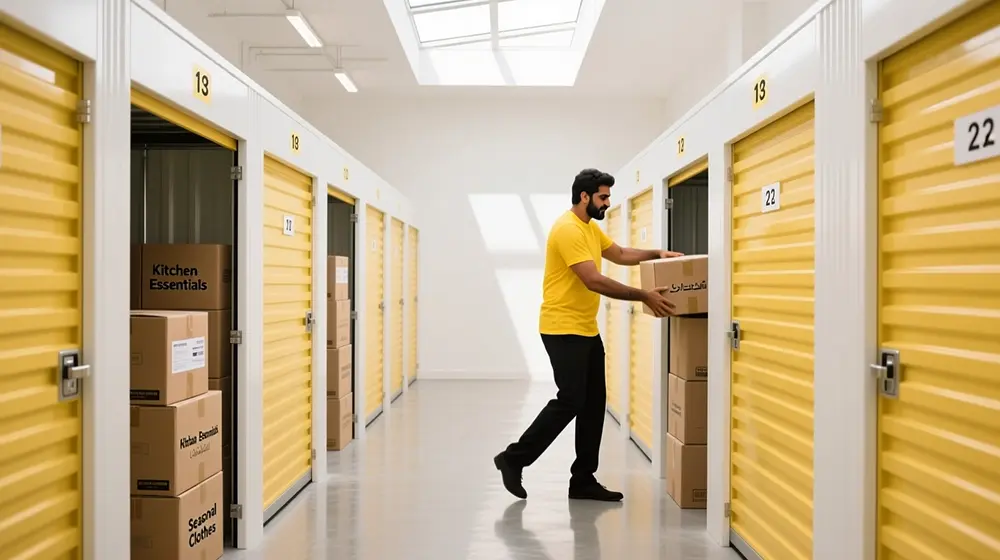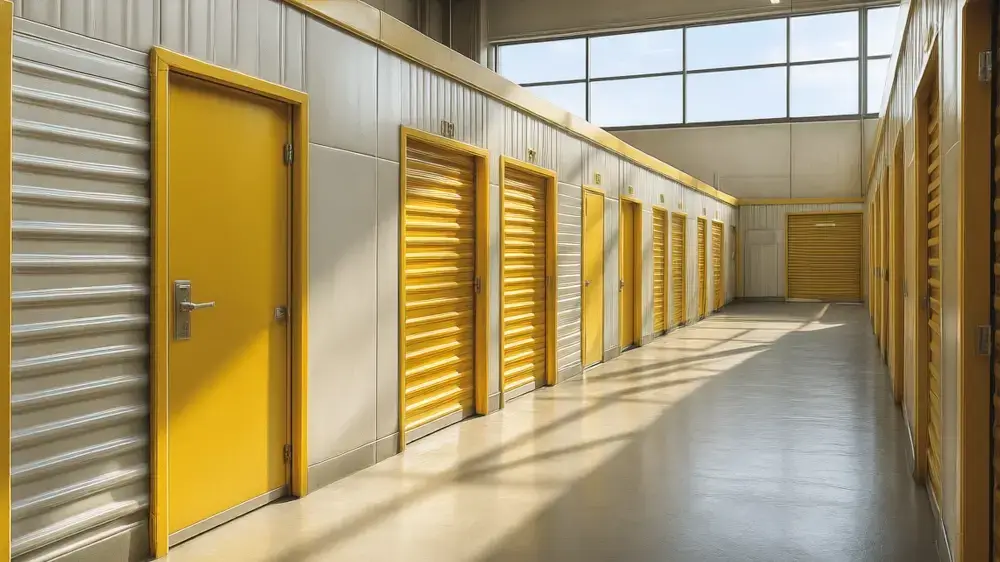Relocating within Sharjah raises one hidden risk. Climate and humidity increase damage during moves. Heat and humidity risk is the hidden reason. Sharjah records summer highs near 40 to 41 °C, with coastal humidity that accelerates damage. Lease renewals after the three-year mark create timing gaps during moves. Climate-controlled self storage separates move-out and move-in dates and protects items.
Self storage solves these pain points. Climate-controlled units stabilize temperature and relative humidity. Staging decouples move-out and move-in dates. Hallways and lifts stay clear for crews. Paperwork proceeds without clutter.
This professional guide explains the Sharjah climate context and its effect on belongings. It outlines unit sizing for studios and two bedrooms. It details packing controls for heat and moisture. It closes with a move checklist and concise answers for faster, safer handovers.
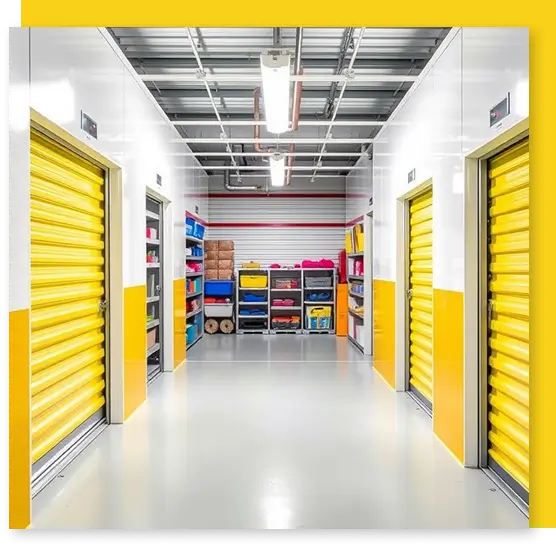
Why is climate control the hidden risk reducer when relocating within Sharjah?
Relocating within Sharjah exposes belongings to peak summer heat and coastal humidity during staging and handover. August averages about 40 °C by day and ~30 °C at night, with the hot season above 37 °C from roughly 19 May to 25 September. In 2025, the UAE recorded 51.8 °C at Sweihan on 1 August, per the National Centre of Meteorology coverage. Climate-controlled self storage reduces exposure during these windows and lowers damage probability.
Sharjah Late-Summer Conditions: What Movers Should Know
Heat and moisture rise together in late summer. Average August highs near 40 °C and warm nights increase moisture load inside lifts, vans, and corridors. These conditions persist across coastal districts during intra-city moves. Regulated storage limits temperature and stabilizes relative humidity during staging.
What materials degrade fastest in hot, humid air?
Photographs and paper perform best in a cool, stable environment around 30–50 % RH and 21 °C or below. Guidance warns against daily swings and high RH because gelatin binders soften and adhesives creep. Lower RH further slows dye fade in color media.
Electronics face leakage paths and creep corrosion when RH stays high, especially with airborne sulfur or dust. Industry studies document corrosion across multiple PCB surface finishes. iNEMI testing shows humidity management is necessary but not sufficient when contaminants are present. Climate-controlled self storage creates time buffers to dry, pack, and stage electronics away from peak humidity.
Sharjah Storage Best Practices: Practical Climate-Control Targets
Conservation and preservation sources align on cool, dry, and stable conditions for mixed household goods. Facilities that regulate both temperature and RH best protect sensitive items during an intra-city move.
| Item class | Primary risk in hot-humid staging | Practical band |
|---|---|---|
| Photographs, prints, negatives | Mold, emulsion softening, dye fade | ≈30–50 % RH; ≤ 21 °C; minimal fluctuation |
| Paper records, albums | Cockling, foxing, adhesive creep | ≈35–50 % RH; cool, stable |
| Color photos and films | Dye fade, hydrolysis | Lower end of 20–50 % RH range; colder improves stability |
| Consumer electronics | Creep corrosion, dendrites | Controlled RH; clean, dry before sealing |
Practical Steps to Apply Climate Targets During a Sharjah Move
- Stage heat-sensitive items in a climate-controlled unit before handover. Match setpoints near 18–24 °C and 30–50 % RH.
- Load and unload at cooler hours during August heat alerts to limit RH cycling in vans and corridors.
- Box photographs and records in enclosure systems that buffer RH; keep containers off floors to reduce condensation risk.
- Dry and clean electronics before sealing; limit dwell time in unconditioned spaces to reduce corrosion drivers.
Bottom line. “Relocating Within Sharjah? Why Self Storage Is Your Best Move” holds because climate-controlled self storage aligns real Sharjah climate numbers with preservation targets from the Library of Congress and NEDCC, and with electronics reliability data. The alignment cuts the risk during the move window and supports a smoother handover.
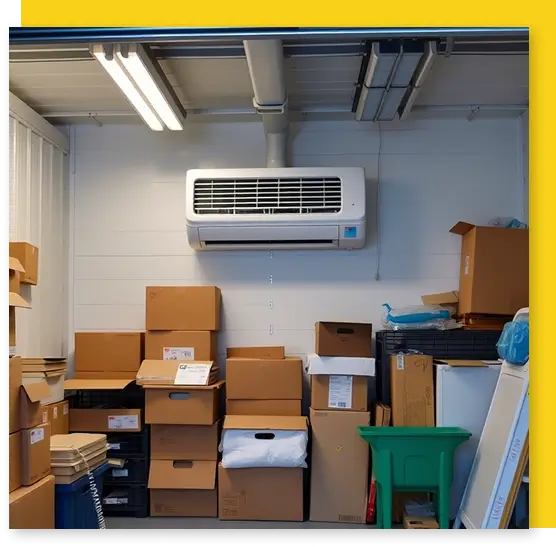
How hot is Sharjah in the peak moving months?
Relocating within Sharjah often happens in the hottest window of the year. The hot season lasts from 19 May to 25 September with average daily highs above 37 °C. August is the hottest month, averaging ~40 °C by day and ~30 °C at night. These figures come from long-term climate normals for Sharjah.
Extreme events sharpen the risk case for climate-controlled self storage. On 1 August 2025, the UAE’s National Centre of Meteorology reported 51.8 °C at Sweihan, a nine-year August high and close to the national record. Coastal cities ran in the mid-40s that week.
Sharjah, United Arab Emirates Weather Averages
Based on annual weather averages for Sharjah, the table below displays max and min temperature and rain data as an average taken from last 12+ years of historical data for Sharjah.
| Month | Typical daytime high | Typical night temp | Rainfall signal |
|---|---|---|---|
| May | 36–38 °C | 27 °C | ~1 mm |
| June | 39–40 °C | 30 °C | ~0 mm |
| July | ~40 °C | 31 °C | ~0 mm |
| August | ~40 °C | ~31 °C | ~0 mm |
| September | ~38 °C | 29 °C | ~0 mm |
Implications for “Relocating Within Sharjah? Why Self Storage Is Your Best Move.”
High daytime temperatures and warm nights keep relative humidity elevated in corridors, elevators, and vans. Zero-rain months do not mean dry air indoors. Heat plus humidity accelerates material failure. Climate-controlled self storage reduces exposure during staging and handover.
- Plan loading in early morning or evening during August alerts from the NCM and major outlets.
- Treat 18–24 °C and 30–50 % RH as practical targets when choosing a unit. These bands align with conservation guidance for sensitive goods.
Key figures at a glance: August average high ~40 °C. Average night ~30–31 °C. Hot-season threshold >37 °C for ~4.2 months. UAE inland extreme 51.8 °C on 1 Aug 2025. These conditions justify climate-controlled self storage during an intra-Sharjah move.
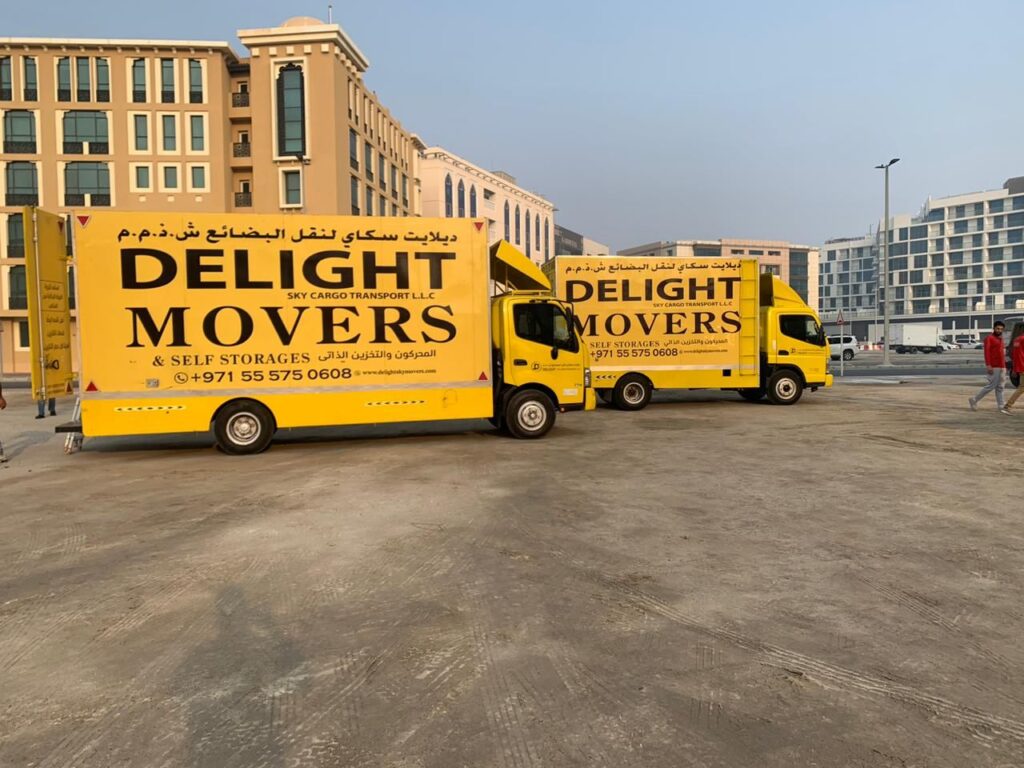
Why does humidity matter for storage during a Sharjah move?
Relocating within Sharjah often coincides with a hot, humid arc (about 19 May–25 September) when average daily highs exceed 37 °C and August runs near 40 °C by day and ~30 °C at night. Warm nights keep air moisture-laden inside corridors, lifts, and vans. In this context, climate-controlled self storage creates a stable microclimate that protects belongings while you bridge move-out and move-in dates.
Why relative humidity drives loss during staging
Relative humidity (RH) governs moisture activity in materials. At high RH, biological growth accelerates, adhesives creep, and metals corrode; at low and stable RH, rates slow. Library of Congress guidance for photographs calls for a “relatively dry” 30–50 % RH, cool temperatures (≈ ≤ 21 °C), and minimal fluctuation; NEDCC echoes the same ranges and warns that fluctuations themselves cause damage. These are the same conditions a good climate-controlled self storage unit aims to maintain.
Three fast-acting mechanisms in Sharjah’s climate
- Mold initiation: Risk rises quickly once RH stays above ~65 % at room temperature; elevated August nights make that plateau common in unconditioned spaces. Climate-controlled storage keeps RH below this threshold.
- Adhesive and binder softening: Photographic gelatin binders become tacky at high RH; cockling and image deterioration follow. Stabilizing RH near 30–50 % limits these failures during staging.
- Creep corrosion on electronics: Humid, contaminated air fosters dendrites and corrosion migration across PCB features; iNEMI studies document the dependence on RH. Controlled-RH storage reduces exposure between flats.
Practical RH/temperature bands to request from a storage provider
Ask for active control of both temperature and RH, not “shaded” or “ventilated” only. Compare their setpoints and allowed daily variance to conservation benchmarks.
| Material class | Primary humidity risk in Sharjah moves | Recommended band (storage/staging) |
|---|---|---|
| Photographs, negatives, prints | Mold, emulsion softening, dye fade | ~30–50 % RH; ≤ 21 °C; small daily swings |
| Paper records, albums | Cockling, foxing, adhesive creep | ~35–50 % RH; cool, stable |
| Consumer electronics (PCBs) | Creep corrosion, leakage paths | Controlled RH; clean/dry before sealing |
What does this mean for “Relocating Within Sharjah? Why Self Storage Is Your Best Move”
- Sharjah climate reality. Hot-season highs above 37 °C and warm nights mean persistently high indoor RH without active conditioning.
- Preservation targets. Accredited guidance converges on ~30–50 % RH and cool, stable temperatures for mixed household goods.
- Operational takeaway. Choose climate-controlled self storage that publishes RH/temperature setpoints and variance; stage sensitive items there first to avoid unconditioned dwell time during handovers.
Sharjah’s High-Activity Districts Where Nearby Self Storage Saves Hours
Relocating within Sharjah often means moving between dense apartment hubs where elevator demand and short booking windows stretch timelines. The fastest way to keep a local move on schedule is to place a self storage unit close to the pickup or drop-off district. Bayut’s current listings and market snapshots identify five areas with heavy apartment stock and active leasing: Al Nahda, Al Khan, Al Majaz, Al Taawun, and Muwaileh. High listing volumes and mid-rise to high-rise building stock translate into more elevator queues and tighter loading slots. Storage within a few kilometers reduces van idle time, staging delays, and exposure to heat and humidity during handovers.
Why proximity matters for intra-city moves
More apartments per block means more weekend handovers, more building permit windows, and longer waits for service elevators. In these five districts, when a ground team can stage boxes and delicate items in a nearby storage unit, they shorten the elevator cycle, load in cooler hours, and cut repeat trips between buildings and trucks.
District-by-district planning guide
| Sharjah district | Evidence of active leasing | Current rental benchmark | What does this mean for moving logistics | Storage siting tip |
|---|---|---|---|---|
| Al Majaz | ~2,939 properties listed for rent | Avg. asking rent ~AED 58k per year | High-rise density around the lagoon increases weekend elevator demand | Choose storage on Corniche St or ring roads to avoid lagoon-side congestion |
| Al Khan | 1,972 apartments listed; Maryam Island among top sub-areas | Avg. apartment rent ~AED 61.7k per year | Coastal towers compress loading docks during peak hours | Site storage near Al Khan St or E11 access for quick hops |
| Al Taawun | Wide stock across Taawun Street and New Taawun Road | Avg. apartment rent ~AED 48.2k per year | Border-adjacent buildings see heavy move flows at the month’s end | Keep storage near Al Taawun or Al Ittihad corridors for short van legs |
| Al Nahda (Sharjah) | Persistent high search interest and supply; +3% six-month rent shift | Listings from ~AED 22k annually | Continuous churn in mixed-height towers extends elevator queues | Place storage near the Sahara Centre axis to split trips efficiently |
| Muwaileh | Large pipeline across Al Mamsha and Al Zahia | Avg. apartment rent ~AED 43.2k per year | Student cycles and handovers cluster at term starts | Pick storage along University City Rd for fast staging |
How storage near these hotspots cuts real time out of your move
- Shorter elevator cycles: In towers with hundreds of units, one missed elevator slot can add 20 to 40 minutes. Staging cartons in a nearby unit lets crews pre-pack and dispatch in smaller waves that fit building windows.
- Less van idle and re-parking: High-activity blocks limit curb space. Storage within the same district reduces re-parking between loads and lowers meter time and driver hours.
- Cooler-hour loading without schedule risk: With storage close by, teams can load sensitive items at 06:00 to 08:00 or after sunset and hold them in climate control until the service elevator opens.
- Lower handling risk for fragile items: Fewer building-to-van trips and shorter carry paths reduce impact and humidity exposure, which is valuable during peak summer.
Proof points you can use in a plan
- Popularity and supply: Bayut’s Sharjah rollups consistently place Al Majaz, Muwaileh, Al Nahda, Al Taawun, and Al Khan among the most sought-after rental areas, reflecting high ongoing transaction and move activity.
- Quantified load on facilities: Thousands of live listings in Al Majaz and nearly two thousand in Al Khan, reinforcing the case for elevator and dock competition at the end of the month.
- District-level rent benchmarks: Average asking rents provide a size and turnover proxy. Recent snapshots show ~AED 58k in Al Majaz, ~AED 61.7k in Al Khan, ~AED 48.2k in Al Taawun, ~AED 43.2k in Muwaileh, and entry bands around AED 22k in Al Nahda. These active ranges map to steady lease starts and ends.
What Needs Climate-Controlled Storage in Sharjah’s Heat and Why It Saves Your Move
Climate-controlled self storage (kept roughly 18–24 °C with 30–50 % RH) prevents failures during the handover gap and protects resale value on electronics, instruments, photographs, art, leather, sneakers, cosmetics, candles, and wood furniture.

Electronics: corrosion and “creep” under humidity
Printed-circuit assemblies corrode faster as moisture rises; reliability groups recommend keeping RH under 60 % and temperature 18–27 °C, with dew point held in the 5.5–15 °C band, to stop dendrites and “creep corrosion.” In Sharjah’s late-summer nights, ambient RH can push well above 60 %, so storing TVs, laptops, game consoles, and routers in climate control before and after move day is a measurable risk reduction. Dry components before sealing, and avoid unconditioned dwell time.
Musical instruments: wood and glue respond to RH swings
String, woodwind, and keyboard instruments are healthiest around 40–60 % RH in a cool, stable room. Below the band, plates and fingerboards can shrink and crack; above it, swelling, loose glue joints, and corrosion on metal parts accelerate. For intra-city moves, a climate unit lets you stage cases overnight without exposing them to wet loading bays.
Photographs and negatives: cool and relatively dry
Archive authorities specify 30–50 % RH and ≤ 21 °C for mixed photo collections, with minimal daily fluctuation; color materials benefit from the lower end of 20–50 % RH. That means photo albums, negatives, slides, and inkjet prints go straight to climate control, not to a warm lift lobby where RH spikes. Use enclosure systems and keep boxes off the floor to avoid condensation.
Canvas art and framed works: paint films and textiles move with moisture
Paint layers, canvas, and adhesives expand and contract at different rates; repeated RH cycling causes cupping, cleavage, and loss. Keeping art near 30–50 % RH in a temperature-stable locker during the move window minimizes flex and keeps varnish behavior predictable. (Pair with upright transport and rigid face protection during the load.)
Leather goods and handbags: mold above ~65 % RH
Leather thrives in a narrow RH range; conservation labs warn that > 65 % RH plus heat drives fungal growth and staining, while very dry air (< 30 % RH) causes stiffening. For bags, belts, and jackets, climate storage pins RH near the mid-40s to low-50s and keeps temperatures around 18–20 °C, so finishes and stitching survive the move.
Wood furniture: dimensional change and mold control
Furniture tolerates a moderate band but is vulnerable to RH cycling and high-RH mold. Museum standards for paper/wood collections cluster around 30–50 % RH with cool temperatures; keep pieces in climate storage during any multi-day handover to limit warping, veneer lift, and joint creep.
Quick picks: when climate-control is non-negotiable
- Stage first into climate storage: electronics, instruments, photo archives, framed art, leather bags.
- Short climate hold (24–72 hours) when crossing hot corridors or waiting for keys: sneakers, cosmetics, candles, wood furniture.
- Always aim for 18–24 °C and 30–50 % RH during the move buffer.
Bottom line for “Relocating Within Sharjah? Why Self Storage Is Your Best Move”
A climate-controlled unit gives you a verified environment with temperatures in the teens to low-20s Celsius and relative humidity capped near 50 % that aligns with conservation and reliability targets across the categories most likely to suffer in coastal summer conditions. Use it as your move buffer to keep sensitive items stable, claims off your ledger, and timelines intact.
The definitive case for self storage in intra-Sharjah relocations
Sharjah’s summer climate, the humidity sensitivity of household materials, and the emirate’s rent-timing rules create a predictable risk window during local moves. Climate-controlled self storage closes that window by stabilizing temperature and relative humidity, compressing van cycles, and bridging lease dates. The figures below show why a short self storage stint is the best operational move for “Relocating Within Sharjah”.
Climate makes unconditioned staging risky
In August, Sharjah records average daily highs around 40–41 °C and nights that hover near 29–31 °C, with the month ranked the hottest of the year. Even a short dwell in a lift lobby, corridor, or parked van exposes boxes to heat and moist marine air that drives mold and corrosion. These are not edge cases; August is consistently the peak, and the broader hot season runs for about four months with average highs above 37 °C.
Why storage solves it: A climate unit keeps contents in the teens to low-20s °C rather than the 40 °C ambient seen outdoors and inside vehicles, so cartons, adhesives, and finishes do not soften, and electronics do not take on moisture.
Materials you own have quantified RH and temperature limits
Conservation authorities specify tight bands for common household items that frequently transit during a move. The Library of Congress recommends photo storage in a cool environment at or below ~21 °C with 30–50% RH, and warns against daily RH cycling; NEDCC echoes 30–50% RH with fluctuation under ±10% per day for mixed photographic collections. Electronics reliability bodies (iNEMI, referencing ASHRAE) advise 18–27 °C with RH below 60% and a dew point near 5.5–15 °C to limit creep corrosion on circuit boards. A climate-controlled locker meets these targets during the handover buffer, while a truck box or corridor usually does not.
Sharjah move takeaway: photographs, color prints, laptops, TVs, and routers see a real reduction in failure probability when staged in climate control rather than sitting in an unconditioned hallway or van during August afternoons.
Rent law creates timing gaps that storage can bridge
Under Law No. 5 of 2024, landlords in Sharjah cannot increase rent for the first three years from the contract start unless both parties agree. If a tenant accepts an early increase within that first three-year period, no second increase is permitted for two additional years. These clauses shift renewals to fixed calendar windows, which frequently produce short gaps between keys when handovers, attestations, or snag fixes slip by a few days. A short-term storage unit acts as a buffer that prevents rushed, heat-exposed moves in those gaps.
Sharjah move takeaway: even a 3–10 day storage buffer absorbs typical renewal and handover slippage while keeping sensitive goods in spec.
How to put self storage to work during an intra-Sharjah move
- Sequence packing and staging to the climate band: Move photographs and electronics to storage first so they sit at ≤ 21 °C and 30–50% RH while you handle paperwork and elevator slots.
- Use storage to compress van cycles: Pre-position cartons in the unit and shuttle during the building’s service-elevator window, rather than holding goods in a hot truck at ~40 °C ambient.
- Schedule storage around the rent window: If your three-year mark or an agreed-upon early increase is approaching, reserve a week-long storage buffer to cover attestation or snag delays without exposing sensitive items to heat and humidity.
Bottom line
The numbers align: August heat near 40–41 °C, conservation targets at 30–50% RH and ≤ 21 °C for photos, and electronics guidance at 18–27 °C with RH under 60%. Pair those with Sharjah’s rent-increase timing windows, and a short, climate-controlled self storage rental becomes the decisive tool that reduces damage probability, cuts van hours, and keeps your intra-city relocation on schedule.
Conclusion: Climate-Controlled Self Storage Makes Sharjah Moves Safer
Relocating within Sharjah is not the hard part. Heat and humidity are. They act fast. They damage electronics and photos. They stress wood and leather. They raise risk during staging and handover.
Climate-controlled self storage cuts that risk. It holds the temperature steady. It keeps relative humidity in a safe band. It decouples move-out and move-in dates. It keeps hallways clear. It keeps vans off the curb. It keeps claims off your ledger.
Use it as a buffer. Stage sensitive items first. Pack to the climate band. Load at cooler hours. Place your unit close to your building. You gain time. You lower stress. You protect value.
The numbers and guidance align. Sharjah summers run hot. Conservation targets are clear. Electronics limits are known. A short storage stint bridges timing gaps and weather spikes. The result is a smoother handover. The result is a safer move.
Quick takeaways
- Choose climate-controlled units.
- Aim for 18 to 24 °C and 30 to 50 percent RH.
- Stage electronics, photos, art, and leather first.
- Load early morning or evening.
- Site storage near Al Majaz, Al Khan, Al Taawun, Al Nahda, or Muwaileh if relevant.
You are ready to move within Sharjah with control. Protect what matters. Keep your timeline tight. Let climate-controlled self storage do the heavy lifting.
FAQs
Why is climate-controlled self storage important for Sharjah moves?
Because heat and coastal humidity peak in summer. A controlled unit keeps items at a safe temperature and RH.
What items need climate control the most?
Electronics. Photographs and albums. Art. Leather goods. Wood furniture. Cosmetics and candles also benefit.
What settings should I ask a storage provider for?
Target 18 to 24 °C. Target 30 to 50 percent RH. Ask about daily variance. Ask if both temperature and RH are actively controlled.
How long should I rent a unit during a local move?
Plan for 3 to 10 days. Extend if keys or attestations slip.
When should I move items into storage during the process?
Stage sensitive items first. Do it before packing the rest. Keep them in spec while the paperwork finishes.
What time of day should I load and unload?
Early morning. Late evening. Avoid peak afternoon heat.
How do I pack for heat and humidity?
Use sealed boxes with RH-buffering enclosures for photos and paper. Keep boxes off the floor. Dry and clean electronics before sealing.
What unit size fits a studio or a two-bedroom?
Studios often fit in 25 to 50 square feet. Two bedrooms often fit in 75 to 100 square feet. Confirm with your inventory list.
Does the proximity of the storage site matter?
Yes. Nearby units cut elevator waits. They reduce van idle time. They enable cooler-hour loading without schedule risk.
Can a unit help if my lease timing changes?
Yes. It bridges the gap between move-out and move-in. Your goods stay protected while dates shift.
